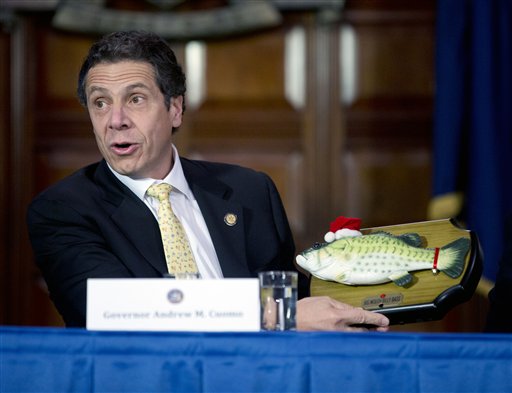

Suffolk County Legis. Wayne Horsely (D-Babylon) speaks at a Long Island First meeting on Tuesday, May 22, 2012 (Steve Gravano)
A new plan to grow the Long Island economy took a major leap forward Tuesday day as a group of elected officials, business leaders and civic advocates from Nassau and Suffolk met to discuss how to make “Long Island First” a reality.
The local initiative, which grew out of one of the strategies devised by the Long Island Regional Planning Council (LIRPC) in its “Long Island 2035” report, would enable closer coordination of business to business transactions within the region. It would help local companies compete with larger chains or off-Island competitors, help market and promote LI-based products and services—agriculture in particular—as well as home-grown technology and other local enterprises.
“This could really shake up Long Island!” Legis. Wayne Horsley (D-Babylon), chairman of the Suffolk Legislature’s economic development, higher education and energy committee, said at the meeting in the basement conference room of the Bank of America building in Melville.
Rather than Nassau vying against Suffolk for business, Legis. Denise Ford (R-Long Beach), chairwoman of the Nassau Legislature’s economic and community development and labor committee, said “We are going to work as one Long Island.”
The two lawmakers joined forces to author bills in their respective legislatures establishing “Long Island First.” The idea has gotten off the ground with the assistance of the Long Island Association Chief Executive Officer Kevin Law and Long Island Regional Planning Council Executive Director Cara Longworth and Chairman John Cameron.
“If you look at Long Island’s challenges they all really weave together,” said Cameron, adding that the goal is to “have us support each other” by purchasing “products and services from each other.”
“Buying local,” as Pearl Kamer, chief economist for the Long Island Association, explained in her presentation before the working group, would have a “multiplier or ripple effect.” She said it could be estimated using a model prepared by the U.S. Commerce Department and used by the LIA for its analysis.
A million dollars spent by the construction industry, for example, on local products and services that remain on LI might double the output to $2 million, increase earnings by $635,700 and add 15 more full-time jobs.
Under this initiative, LI companies would be encouraged to purchase products and services from other LI businesses first, rather than look for out of state or upstate. The goal is to retain a more significant portion of the Island’s “multi-billion dollar” gross domestic product within the LI economy, Cameron said.
But achieving that goal is not going to be easy when other regions are able to compete successfully due to their lower costs. Long Island Farm Bureau’s Joseph Gergela, a member of the new working group, said grocery store chains often find it more economical to ship produce in from other states rather than from LI farmers.
That’s in part because the major suppliers already have the shipping and packaging facilities they need to move massive amounts of produce and benefit from economies of scale. But group members had hopes that this initiative may raise consumer awareness about the importance of buying locally grown products, and that increased demand may pay off in the long run.
JP DiMartino, an aide to Horsley, said that the Long Island First interactive website, which would enable businesses and services to connect with other local venders at the click of a mouse, might be up and running by the fall, but it could require “tens of thousands of dollars” to make it fully functional. Subcommittees of the “Long Island First” working group plan to meet several times this summer to iron out the details.
Another hurdle involves changing how local municipalities bid so that local firms get preference without risking litigation from outside entities claiming unfair business practices.
There was an air of urgency in the room, perhaps due to yesterday’s release of LI unemployment figures from the state labor department showing that the rate had jumped in April to 7.1 percent from 6.6 percent a year ago. The New York unemployment rate is 8.1 percent and the national rate is 7.7 percent.
“Long Islanders don’t realize all the products and services they have here,” said Horsley. “We have got to market ourselves—we must market Long Island to Long Islanders.”






